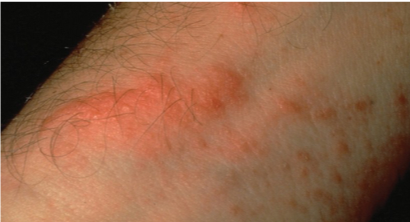I have A rash on my face that never goes away and get s worse with time. Once sensitized additional and sometimes increasingly severe reactions become likely upon future exposures even to tiny amounts of epoxy.

The Reality Of Epoxy Sensitization Coatingspro Magazine
Dont scrub too hard that may cut the skin letting some in anyway.

How to treat epoxy rash. The best way to get relief is to apply masking tape to the affected area then gently pull it off. If the rash is caused by. If you are diagnosed with epoxy resin allergy then avoid exposure to epoxy containing products otherwise take means to reduce potential exposure.
By warming the bottles you can jump start the reaction with additional heat. I waited for the full 2 weeks cure time before sanding epoxy and wore no dust mask. Washing the area immediately with soap and water should treat accidental exposure from glue or paints.
I t is possible to develop an allergy to epoxy resinAbout 2 of epoxy resin users will start to develop an allergic reaction to the chemical components of the epoxy resin. Warm up your resin and hardener bottles in a hot water bath for about five to ten minutes. The idea is to surround the epoxy in the soap the soap renders the surface non.
Typically symptoms of epoxy resin allergy develops slowly over time. I have a rash on forarms and for head Eyelids Itchy as HellAt work I spray epoxy urathane with zylene and MEK solvents I got splashed 10 days ago Washed with water for 30 mins use Hydrocortison. After that I was much more careful working with the stuff.
Contact dermatitis is the most common allergic reaction to epoxy resin and tends to occur when there is skin contact with uncured epoxy resin. I stayed away from epoxy for 2 weeks and the rash went away. How do you treat adhesive allergic reaction.
To treat skin rash caused by an allergic reaction apply an over-the-counter topical treatment like hydrocortisone to the affected area twice daily for 2 weeks. Solvents just make the epoxy worse than 100 solids which are epoxy dangerous. Embedded fibers will come away with the tape.
I use a Q-tip. While bisphenol A is the main allergen other components eg epichlorohydrin diglycidyl ether may also cause skin irritation. It is important to prepare and protect yourself from coming in contact with the epoxy itself and its fumes as well as understand the specific material you are working with and receive training for your specific application process.
Paper towel off the excess epoxy then squirt dishsoap over the area and scrape or brush off--I use a scrub brush by the sink. Those who see an allergic reaction would develop a response to the epoxy resin in general. Do not use any epoxy incuding coatings that have solvents in them.
Regardless of when reactions occur or their severity allergy sufferers should discontinue use of ALL epoxy resins indefinitely in order to protect themselves. Nitrile rubber or nitrile butyl gloves in addition to goggles and protective clothing are recommended for avoidance. Use only 100 solids low odor low VOC no solvents epoxy.
After hardening wipe the surface of the epoxy with acetone. Back in my radiation research days I used a 51 epoxy. Johny Chacko Dermatologist.
Can epoxy cause rashes. Epoxy resin is widely used for sporting goods dental work and vehicle parts. There are no fumes zero with West System epoxies.
I have been to every DR. You can use a vacuum to remove fiberglass dust but the discomfort may persist if fiberglass shards are embedded in your skin. Unfortunately it is impossible to tell whether someone will have an epoxy allergy until symptoms present themselves.
There is no specific antidote for epoxy sensitization but symptoms can sometimes be treated with medicine. I recently took a. The best way to get rid of liquid epoxy is to emulsify it in somethingliquid dishsoap with no water added works well.
Sometimes solvents acetone alcohol or methyl-ethyl ketone can be used to reduce the exposure. This will remove traces of unhardened resin or excess hardener from the surface without significantly noticeably affecting the polymerized mass. Use only Xylene to thin epoxy - dont inhale it.
If you want to learn more about this be sure to check out the article what temperature should I. Choose a Wheel Kit Here. I wore a haz-mat suit along with my nitrile gloves but no respirator.
For patients with dermatitis related to exposure corticosteroids and emollients are frequently used for treatment. This will help the resin to cure faster. And prescribed every sort of medication and steriod creams and nothings helps.

Occupational Dermatitis Annals Of Allergy Asthma Immunology

Allergic Contact Rashes Dermatologist In Tupelo Ms Dermatology Center Of North Mississippi Pa

The Diagnostic Evaluation Treatment And Prevention Of Allergic Contact Dermatitis In The New Millennium Journal Of Allergy And Clinical Immunology
Contact Dermatitis And Allergic Skin Irritants Testing Treatment


0 comments:
Post a Comment